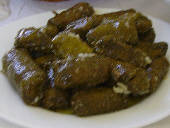n Greek: ντολμαδάκια με κιμά, pronounced dohl-mah-THAHK-yah meh kee-MAH
These small bundles of meat and rice wrapped in grape leaves are a favorite dish in Greece. The name comes from the Turkish word “dolma” meaning “stuffed.” They are time- and labor-intensive to make, so the recipe is for a pretty large quantity. They can be stored in the refrigerator for several days, or frozen.

Dolmathakia: stuffed grape leaves
Cook Time: 1 hour
Total Time: 1 hour
Ingredients:
- 1 jar of large grape leaves in brine (about 60-75 leaves) or about 180 small leaves
- 8 cups of water
- 2 pounds of lean ground beef
- 1 cup of uncooked short-grain rice
- 2 medium-large onions, finely chopped
- 5 tablespoons of olive oil
- 1 bunch of fresh dill, chopped
- 1 tablespoon of fresh mint, chopped
- juice of 3 lemons
- 1/4 teaspoon of pepper
- 1 teaspoon of sea salt
- 2 cups of water
Preparation:
Blanch the Grape Leaves
Bring 8 cups of water to a boil in a large pot, add juice of 1/2 lemon and the salt. Carefully unroll the leaves (do not separate them). Turn off the heat and place leaves in the hot water for 3 minutes. Remove leaves and place them in a bowl and cover with cold water. When cooled, drain in a colander. It is not unusual for many of the outer leaves in the jar or can to be damaged, or to tear while using. Set these aside to use later in the recipe.
Prepare the Filling
Soak the rice for 10 minutes in hot water and drain. (Alternatively, sauté the rice with the onion.) Sauté the onions in 1 tablespoon of olive oil until translucent, not browned. In a bowl, combine the onions, ground beef, rice, remaining olive oil, dill, mint, juice of 1 lemon, and pepper. Mix well by hand.
Filling and Rolling the Leaves
Gently separate one leaf and place it shiny side down on a work surface. Place a pinch (up to a teaspoon) of the filling on the leaf at the point where the stem joined the leaf. Fold up the bottom of the leaf over the filling, then each side inward in parallel folds, and roll up the leaf. Roll should be firm, not tight, as the filling will expand during cooking. Repeat until all the filling has been used.
Cooking the Stuffed Grape Leaves
Because the leaves on the bottom can burn while the filling cooks, put a plate or wooden souvlaki skewers in the bottom of a heavy-bottomed pot (see tip below). The plate should fit as closely as possible to the sides. If there are unused leaves, or leaves that were torn and not used during the filling process, put them on the plate or on top of the skewers. Place the dolmathakia on top, packing them closely together (not squashed), seam side down, so they don’t unroll during cooking. Layer them until all are in the pot (2-3 layers is best, but no more than 4 layers). Place several unused leaves over the top. Take another plate and place it upside down on top of the dolmathakia, with something to weight it down (a second plate works well). Add 2 cups of water to the pot and cover. Bring the water to a gentle boil, add the remaining lemon juice, reduce heat to low and simmer for approximately 50-70 minutes. Check to see if done. If the rice has cooked, they are done. If not, continue cooking for another 10 minutes and check again. Cooking time depends both on the type of pot used and the particular stovetop element.
If preferred, use a pressure cooker. No plates needed, but do use the skewers in the bottom. Pack the dolmathakia into the pressure cooker, add the 2 cups of water, close and cook for 15-20 minutes at the first pressure mark.
Serving
Individual servings of dolmathakia are 4-5 pieces on small plates as an appetizer, however they can also be used as a side or main dish. Serve dolmathakia warm or at room temperature with avgolemono (egg and lemon sauce), lemon wedges, tzatziki, or unflavored yogurt on the side.
Storage
These will keep well in the refrigerator for about 5 days. Return to room temperature before serving. Drizzle olive oil on top and cover to store. They can also be frozen. If you do freeze, reheat in the microwave or by steaming and serve warm. Don’t just thaw and eat.
Tips:
- If you don’t have a plate that fits or skewers, line the bottom of the pan with unused or torn leaves.
- Leftover filling can be used to make stuffed vegetables like tomatoes, peppers, zucchini, and eggplant.
- To make as a main course, use larger grape leaves and increase the amount of filling in each leaf to 1 tablespoon.
